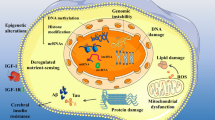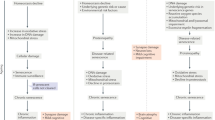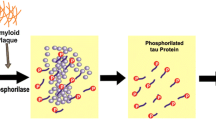Abstract
In Alzheimer's disease, age-related cellular changes such ascompromised energy production and increased radical formation areworsened by the presence of AGEs as additional, AD specificstress factors. Intracellular AGEs (most likely derived frommethylglyoxal) crosslink cytoskeletal proteins and render theminsoluble. These aggregates inhibit cellular functions includingtransport processes and contribute to neuronal dysfunction anddeath. Extracellular AGEs, which accumulate in ageing tissue (butmost prominently on long-lived protein deposits like the senileplaques) exert chronic oxidative stress on neurons. In addition,they activate glial cells to produce free radicals (superoxideand NO) and neurotoxic cytokines such as TNF-α. Drugs, whichinhibit the formation of AGEs by specific chemical mechanisms(AGE-inhibitors), including aminoguanidine, carnosine,tenilsetam, OPB-9195 and pyridoxamine, attenuate the developmentof (AGE-mediated) diabetic complications. Assuming that `carbonylstress' contributes significantly to the progression ofAlzheimer's disease, AGE-inhibitors might also becomeinteresting novel therapeutic drugs for treatment of AD.
Similar content being viewed by others
References
Abordo EA, Minhas HS and Thornalley PJ (1999) Accumulation of alpha-oxoaldehydes during oxidative stress: a role in cytotoxicity. Biochem Pharmacol 58: 641-648
Abordo EA and Thornalley PJ (1997) Synthesis and secretion of tumour necrosis factor-alpha by human monocytic THP-1 cells and chemotaxis induced by human serum albumin derivatives modified with methylglyoxal and glucose-derived advanced glycation endproducts. Immunol Lett 58(3): 139-147
Abordo EA, Westwood ME and Thornalley PJ (1996) Synthesis and secretion of macrophage colony stimulating factor by mature human monocytes and human monocytic THP-1 cells induced by human serum albumin derivatives modified with methylglyoxal and glucose-derived advanced glycation endproducts. Immunol Lett 53 (1): 7-13
Akhand AA, Kato M, Suzuki H, Liu W, Du J, Hamaguchi M, Miyata T, Kurokawa K and Nakashima I (1999) Carbonyl compounds cross-link cellular proteins and activate protein-tyrosine kinase p60(c-src). J Cell Biochem 72: 1-7
Al-Abed Y, Callaway D, Kapurniotu A, Holak T, Voelter W and Bucala R (1999) Model studies of the maillard reaction of arg-lys with D-glucose. Polish J Chem 73: 117-123
Arendt T, Rodel L, Gartner U and Holzer M (1996) Expression of the cyclin-dependent kinase inhibitor p16 in Alzheimer's disease. Neuroreport 7: 3047-3049
Bierhaus A, Chevion S, Chevion M, Hofmann M, Quehenberger P, Illmer T, Luther T, Berentshtein E, Tritschler H, Muller M, Wahl P, Ziegler R and Nawroth PP (1997) Advanced glycation end product-induced activation of nf-kappa-b is suppressed by alpha-lipoic acid in cultured endothelial cells. Diabetes 46: 1481-1490
Booth AA, Khalifah RG and Hudson BG (1996) Thiamine pyrophosphate and pyridoxamine inhibit the formation of antigenic advanced glycation end-products: comparison with aminoguanidine. Biochem Biophys Res Commun 220: 113-119
Braak H, Braak E and Bohl J (1993) Staging of Alzheimer-related cortical destruction. Eur Neurol 33: 403-408
Brownlee M (1995) Advanced protein glycosylation in diabetes and aging. Ann Rev Med 46: 223-234
Brownson C and Hipkiss AR (2000) Carnosine reacts with a glycated protein. Free Radic Biol Med 28: 1564-1570
Bush AI (2000) Metals and neuroscience. Curr Opin Chem Biol 4: 184-191
Castellani RJ, Smith MA, Nunomura A, Harris PL and Perry G (1999) Is increased redox-active iron in Alzheimer disease a failure of the copper-binding protein ceruloplasmin? Free Radic Biol Med 26: 1508-1512
Colaco CA, Ledesma MD, Harrington CR and Avila J (1996) The role of the Maillard reaction in other pathologies: Alzheimer's disease. Nephrol Dial Transplant 11 ( Suppl 5): 7-12
Czech C, Monning U, Tienari PJ, Hartmann T, Masters C, Beyreuther K and Forstl H (1993) Apolipoprotein-e-sigma-4 allele and alzheimers disease. Lancet 342: 1309-1310
Deora AA, Win T, Vanhaesebroeck B and Lander HM (1998) A redox-triggered ras-effector interaction-recruitment of phos phatidylinositol 50-kinase to ras by redox stress. J Biol Chem 273: 29923-29928
Dickson DW, Sinicropi S, Yen SH, Ko LW, Mattiace LA, Bucala R and Vlassara H (1996) Glycation and microglial reaction in lesions of Alzheimer's disease. Neurobiol Aging 17: 733-743
Gartner U, Holzer M, Heumann R and Arendt T (1995) Induction of p21(ras) in Alzheimer pathology. Neuroreport 6: 1441-1444
Hipkiss AR (1998) Carnosine, a protective, anti-ageing peptide. Internat J Biochem Cell Biol 30: 863-868
Hipkiss AR, Michaelis J and Syrris P (1995) Non-enzymatic glycosylation of the dipeptide l-carnosine, a potential antiprotein-cross-linking agent. FEBS Lett 371: 81-85
Hirata C, Nakano K, Nakamura N, Kitagawa Y, Shigeta H, Hasegawa G, Ogata M, Ikeda T, Sawa H, Nakamura K, Ienaga K, Obayashi H and Kondo M (1997) Advanced glycation end products induce expression of vascular endothelial growth factor by retinal Muller cells. Biochem Biophys Res Commun 236(3): 712-715
Horie K, Miyata T, Yasuda T, Takeda A, Yasuda Y, Maeda K, Sobue G and Kurokawa K (1997) Immunohistochemical localization of advanced glycation end products, pentosidine, and carboxymethyllysine in lipofuscin pigments of Alzheimer's disease and aged neurons. Biochemical Biophys Res Comm 236: 327-332
Hoyaux D, Decaestecker C, Heizmann CW, Vogl T, Schafer BW, Salmon I, Kiss R and Pochet R (2000) S100 proteins in Corpora amylacea from normal human brain. Brain Res 867: 280-288
Huang JS, Guh JY, Hung WC, Yang ML, Lai YH, Chen HC and Chuang LY (1999) Role of the Janus kinase (JAK)/signal transducters and activators of transcription (STAT) cascade in advanced glycation end-product-induced cellular mitogenesis in NRK-49F cells. Biochem J 342: 231-238
Ihl R, Perisic I, Maurer K and Dierks T (1989) Effect of 3 months treatment with tenilsetam in patients suffering from dementia of Alzheimer type (DAT). J Neural Trans (P-D Sect) 1: 84-85
Khalifah RG, Baynes JW and Hudson BG (1999) Amadorins: Novel post-Amadori inhibitors of advanced glycation reactions. Biochem Biophys Res Commun 257: 251-258
Khalifah RG, Baynes JW and Hudson BG (1999) Amadorins: Novel post-Amadori inhibitors of advanced glycation reactions. Biochem Biophys Res Commun 257: 251-258
Kikuchi S, Shinpo K, Moriwaka F, Makita Z, Miyata T and Tashiro K (1999) Neurotoxicity of methylglyoxal and 3-deoxyglucosone on cultured cortical neurons: Synergism between glycation and oxidative stress, possibly involved in neurodegenerative diseases. J Neurosci Res 57: 280-289
Kimura T and Horiuchi S (1995) Amyloidosis, advanced glycation end products and Alzheimer disease-reply. Neuroreport 6: 1595-1596
Kimura T, Takamatsu J, Miyata T, Miyakawa T and Horiuchi S (1998) Localization of identified advanced glycation endproduct structures, n-8-(carboxymethyl)lysine and pentosidine, in age-related inclusions in human brains. Pathol Internat 48: 575-579
Ko LW, Ko EC, Nacharaju P, Liu WK, Chang E, Kenessey A and Yen SH (1999) An immunochemical study on tau glycation in paired helical filaments. Brain Res 830: 301-313
Kunt T, Forst T, Wilhelm A, Tritschler H, Pfuetzner A, Harzer O, Engelbach M, Zschaebitz A, Stofft E and Beyer J (1999) Alpha-lipoic acid reduces expression of vascular cell adhesion molecule-1 and endothelial adhesion of human monocytes after stimulation with advanced glycation end products. Clin Sci (Colch) 96 (1): 75-82
Lal S, Randall WC, Taylor AH, Kappler F, Walker M, Brown TR and Szwergold BS (1997) Fructose-3-phosphate production and polyol pathway metabolism in diabetic rat hearts. Metabol Clin Exp 46: 1333-1338
Lander HM, Tauras JM, Ogiste JS, Hori O, Moss RA and Schmidt AM (1997) Activation of the receptor for advanced glycation end products triggers a p21(ras)-dependent mitogen-activated protein kinase pathway regulated by oxidant stress. J Biol Chem 272: 17810-17814
Ledesma MD, Bonay P and Avila J (1995) Tau protein from alzheimers disease patients is glycated at its tubulin-binding domain. J Neurochem 65: 1658-1664
Ledesma MD, Bonay P, Colaco C, and Avila J (1994) Analysis of microtubule-associated protein tau glycation in paired helical filaments. J Biol Chem 269: 21614-21619
Ledesma MD, Perez M, Colaco C and Avila J (1998) Tau glycation is involved in aggregation of the protein but not in the formation of filaments. Cell Mol Biol 44: 1111-1116
Li JJ, Surini M, Catsicas S, Kawashima E and Bouras C (1995) Agedependent accumulation of advanced glycosylation end products in human neurons. Neurobiol Aging 16: 69-76
Li YM, and Dickson DW (1997) Enhanced binding of advanced glycation endproducts (age) by the apoe4 isoform links the mechanism of plaque deposition in alzheimers disease. Neurosci Lett 226: 155-158
Lo TWC, Selwood T and Thornalley PJ (1994) The reaction of methylglyoxal with aminoguanidine under physiological conditions and prevention of methylglyoxal binding to plasma proteins. Biochem Pharmacol 48: 1865-1870
Loske C, Gerdemann A, Schepl W, Wycislo M, Schinzel R, Palm D, Riederer P and Münch G (2000) Transition metal mediated glycoxidation accelerates crosslinking of _-amyloid peptide. Eur J Biochem: 1-9
Loske C, Neumann A, Cunningham AM, Nichol K, Schinzel R, Riederer P and Münch G (1998) Cytotoxicity of advanced glycation endproducts is mediated by oxidative stress. J Neural Trans 105: 1005-1015
Mandelkow E, Song YH, Schweers O, Marx A and Mandelkow EM (1995) On the structure of microtubules, tau, and paired helical filaments. Neurobiol Aging 16: 347-354
Mattson MP, Barger SW, Furukawa K, Bruce AJ, Wysscoray T, Mark RJ and Mucke L (1997) Cellular Signalling roles of TGFbeta, TNF-alpha and beta-APP in brain injury and Alzheimer's disease. Brain Res Rev 23: 47-61
McLean WG (1997) The role of axonal cytoskeleton in diabetic neuropathy. Neurochem Res 22(8): 951-956
McShea A, Harris PL, Webster KR, Wahl AF and Smith MA (1997) Abnormal expression of the cell cycle regulators P16 and CDK4 in Alzheimer's disease. Am J Pathol 150: 1933-1939
Mehlhorn G, Hollborn M and Schliebs R (2000) Induction of cytokines in glial cells surrounding cortical beta-amyloid plaques in transgenic Tg2576 mice with Alzheimer pathology. Int J Dev Neurosci 18: 423-431
Miyata T, Ishikawa S, Asahi K, Inagi R, Suzuki D, Horie K, Tatsumi K and Kurokawa K (1999) 2-Isopropylidenehydrazono-4-oxo-thiazolidin-5-ylacetanilide (OPB-9195) treatment inhibits the development of intimal thickening after balloon injury of rat carotid artery: role of glycoxidation and lipoxidation reactions in vascular tissue damage. FEBS Lett 445: 202-206
Miyata T, Ueda Y, Yamada Y, Izuhara Y, Wada T, Jadoul M, Saito A, Kurokawa K and Destrihou CV (1998) Accumulation of carbonyls accelerates the formation of pentosidine, an advanced glycation end product-carbonyl stress in uremia. J Am Soc Nephrol 9: 2349-2356
Münch G, Mayer S, Michaelis J, Hipkiss AR, Riederer P, Muller R, Neumann A, Schinzel R and Cunningham AM (1997) Influ33 ence of advanced glycation end-products and AGE-inhibitors on nucleation-dependent polymerization of beta-amyloid peptide. Biochim Biophys Acta 1360: 17-29
Münch G, Riederer P, Cunningham A and Braak E (1998) Advanced glycation endproducts are associated with Hirano bodies in Alzheimer's disease. Brain Res 796: 307-310
Münch G, Taneli Y, Schraven E, Schindler U, Schinzel R, Palm D and Riederer P (1994) The cognition-enhancing drug tenilsetam is an inhibitor of protein crosslinking by advanced glycosylation. J Neural Transm-Parkinsons Dis Dementia Sect 8: 193-208
Nakamura S, Makita Z, Ishikawa S, Yasumura K, Fujii W, Yanagisawa K, Kawata T and Koike T (1997) Progression of nephropathy in spontaneous diabetic rats is prevented by OPB-9195, a novel inhibitor of advanced glycation. Diabetes 46: 895-899
Neumann A, Schinzel R, Palm D, Riederer P and Münch G (1999) High molecular weight hyaluronic acid inhibits advanced glycation endproduct-induced NF-kappa B activation and cytokine expression. FEBS Lett 453: 283-287
Nishikawa T, Edelstein D, Du XL, Yamagishi S, Matsumura T, Kaneda Y, Yorek MA, Beebe D, Oates PJ, Hammes HP, Giardino I and Brownlee M (2000) Normalizing mitochondrial superoxide production blocks three pathways of hyperglycaemic damage. Nature 404: 787-790
Onorato JM, Jenkins AJ, Thorpe SR and Baynes JW (2000) Pyridoxamine, an inhibitor of advanced glycation reactions, also inhibits advanced lipoxidation reactions. Mechanism of action of pyridoxamine. J Biol Chem 275: 21177-21184
Preston JE, Hipkiss AR, Himsworth DT, Romero IA and Abbott JN (1998) Toxic effects of beta-amyloid(25-35) on immortalised rat brain endothelial cell: protection by carnosine, homocarnosine and beta-alanine. Neurosci Lett 242: 105-108
Pugliese G, Pricci F, Romeo G, Pugliese F, Mene P, Giannini S, Cresci B, Galli G, Rotella CM, Vlassara H and Di Mario U (1997) Upregulation of mesangial growth factor and extracellular matrix synthesis by advanced glycation end products via a receptor-mediated mechanism. Diabetes 46 (11): 1881-1887
Qian MW, Liu M and Eaton JW (1998) Transition metals bind to glycated proteins forming redox active glycochelates-implications for the pathogenesis of certain diabetic complications. Biochem Biophys Res Commun 250: 385-389
Raina AK, Monteiro MJ, McShea A and Smith MA (1999) The role of cell cycle-mediated events in Alzheimer's disease. Int J Exp Pathol 80: 71-76
Raj DS, Choudhury D, Welbourne TC and Levi M (2000) Advanced glycation end products: a nephrologist's perspective. Am J Kidney Dis 35: 365-380
Sasaki N, Fukatsu R, Tsuzuki K, Hayashi Y, Yoshida T, Fujii N, Koike T, Wakayama I, Yanagihara R, Garruto R, Amano N and Makita Z (1998) Advanced glycation end products in Alzheimers-disease and other neurodegenerative diseases. Am J Pathol 153: 1149-1155
Sayre LM, Perry G and Smith MA (1999) Redox metals and neurodegenerative disease. Curr Opin Chem Biol 3: 220-225
Sheng JG, Mrak RE and Griffin WST (1995) Microglial interleukin-1-alpha expression in brain regions in Alzheimer's disease-correlation with neuritic plaque distribution. Neuropathol App Neurobiol 21: 290-301
Shinohara M, Thornalley PJ, Giardino I, Beisswenger P, Thorpe SR, Onorato J and Brownlee M (1998) Overexpression of glyoxalasei in bovine endothelial cells inhibits intracellular advanced glycation endproduct formation and prevents hyperglycemia-induced increases in macromolecular endocytosis. J Clin Invest 101: 1142-1147
Shoda H, Miyata S, Liu BF, Yamada H, Ohara T, Suzuki K, Oimomi M and Kasuga M (1997) Inhibitory effects of tenilsetam on the Maillard reaction. Endocrinology 138: 1886-1892
Sima AAF, and Cherian PV (1997) Neuropathology of diabetic neuropathy and its correlations with neurophysiology. Clin Neurosci 4: 359-364
Simm A, Münch G, Seif F, Schenk O, Heidland A, Richter H, Vamvakas S and Schinzel R (1997) Advanced glycation endproducts stimulate the MAP-kinase pathway in tubulus cell line LLC-PK1. FEBS Lett 410: 481-484
Smith MA, Taneda S, Richey PL, Miyata S, Yan SD, Stern D, Sayre LM, Monnier VM and Perry G (1994) Advanced Maillard reaction end products are associated with Alzheimer disease pathology. Proc Natl Acad Sci USA 91: 5710-5714
Sugimoto H, Shikata K, Wada J, Horiuchi S and Makino H (1999) Advanced glycation end products-cytokine-nitric oxide sequence pathway in the development of diabetic nephropathy: aminoguanidine ameliorates the overexpression of tumour necrosis factor-alpha and inducible nitric oxide synthase in diabetic rat glomeruli. Diabetologia 42: 878-886
Swearengin TA, Fitzgerald C and Seidler NW (1999) Carnosine prevents glyceraldehyde 3-phosphate-mediated inhibition of aspartate aminotransferase. Arch Toxicol 73: 307-309
Takagi M, Kasayama S, Yamamoto T, Motomura T, Hashimoto K, Yamamoto H, Sato B, Okada S and Kishimoto T (1997) Advanced glycation endproducts stimulate interleukin-6 production by human bone-derived cells. J Bone Min Res 12 (3): 439-446
Takeda A, Yasuda T, Miyata T, Goto Y, Wakai M, Watanabe M, Yasuda Y, Horie K, Inagaki T, Doyu M, Maeda K and Sobue G (1998) Advanced glycation end products co-localized with astrocytes and microglial cells in Alzheimers-disease brain. Acta Neuropathologica 95: 555-558
Takeda A, Yasuda T, Miyata T, Mizuno K, Li M, Yoneyama S, Horie K, Maeda K and Sobue G (1996) Immunohistochemical study of advanced glycation end products in aging and Alzheimer's disease brain. Neurosci Lett 221: 17-20
Thornalley PJ, and Minhas HS (1999) Rapid hydrolysis and slow alpha,beta-dicarbonyl cleavage of an agent proposed to cleave glucose-derived protein cross-links. Biochem Pharmacol 57: 303-307
Tsuchida K, Makita Z, Yamagishi S, Atsumi T, Miyoshi H, Obara S, Ishida M, Ishikawa S, Yasumura K, and Koike T (1999) Suppression of transforming growth factor beta and vascular endothelial growth factor in diabetic nephropathy in rats by a novel advanced glycation end product inhibitor, OPB-9195. Diabetologia 42: 579-588
Vitek MP, Bhattacharya K, Glendening JM, Stopa E, Vlassara H, Bucala R, Manogue K and Cerami A (1994) Advanced glycation end products contribute to amyloidosis in Alzheimer disease. Proc Natl Acad Sci USA 91: 4766-4770
Wells-Knecht KJ, Zyzak DV, Litchfield JE, Thorpe SR and Baynes JW (1995) Mechanism of autoxidative glycosylation-identifi-cation of glyoxal and arabinose as intermediates in the autoxidative modification of proteins by glucose. Biochemistry 34: 3702-3709
Wood JA, Wood PL, Ryan R, Graffradford NR, Pilapil C, Robitaille Y and Quirion R (1993) Cytokine indices in alzheimers temporal cortex-no changes in mature il-1-beta or il-1ra but increases in the associated acute phase proteins il-6, alpha-2-macroglobulin and c-reactive protein. Brain Res 629: 245-252
Yamamoto Y, Yamagishi S, Hsu CC and Yamamoto H (1996) Advanced glycation endproducts-receptor interactions stimulate the growth of human pancreatic cancer cells through the induction of platelet-derived growth factor-B. Biochem Biophys Res Commun 222 ( 3): 700-705
Yan SD, Stern D, Kane MD, Kuo YM, Lampert HC and Roher AE (1998) RAGE-A beta interactions in the pathophysiology of Alzheimer's disease. Restor Neurol Neurosci 12: 167-173
Yan SD, Yan SF, Chen X, Fu J, Chen M, Kuppusamy P, Smith MA, Perry G, Godman GC, Nawroth P, Zweiter JL and Stern D (1995) Non-enzymatically glycated tau in Alzheimer's disease induces neuronal oxidant stress resulting in cytokine gene expression and release of amyloid beta-peptide. Nature Med 1: 693-699
Yang CW, Vlassara H, Peten EP, He CJ, Striker GE and Striker LJ (1994) Advanced glycation end products up-regulate gene expression found in diabetic glomerular disease. Proc Natl Acad Sci USA 91: 9436-9440
Zimmerman GA, Meistrell M III, Bloom O, Cockroft KM, Bianchi M, Risucci D, Broome J, Farmer P, Cerami A, Vlassara H et al. (1995) Neurotoxicity of advanced glycation endproducts during focal stroke and neuroprotective effects of aminoguanidine. Proc Natl Acad Sci USA 92: 3744-3748
Author information
Authors and Affiliations
Corresponding author
Rights and permissions
About this article
Cite this article
Dukic-Stefanovic, S., Schinzel, R., Riederer, P. et al. AGES in brain ageing: AGE-inhibitors as neuroprotective and anti-dementia drugs?. Biogerontology 2, 19–34 (2001). https://doi.org/10.1023/A:1010052800347
Issue Date:
DOI: https://doi.org/10.1023/A:1010052800347




